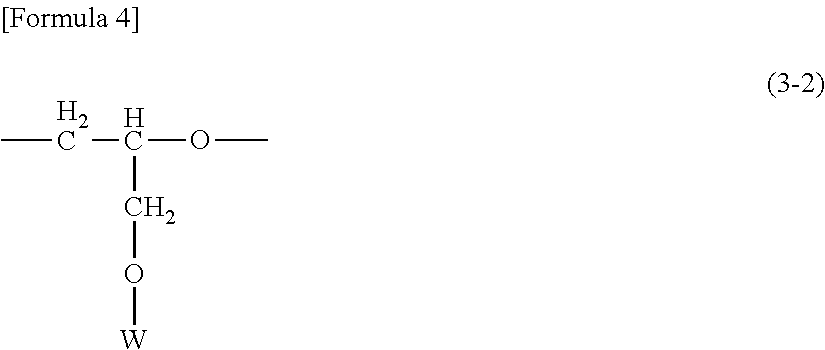Novel Organo Polysiloxane Elastomer And Use Therefor
a polysiloxane and organopolysiloxane technology, applied in the field of new organopolysiloxane elastomers, can solve the problems of inability to withstand use in actual cosmetic formulations, high cost of conventional glycerin-modified silicones or glycerin-modified silicone elastomers, and increase in polyether raw materials, etc., to achieve excellent thickening and gelling properties, excellent feel, and superior thickness
- Summary
- Abstract
- Description
- Claims
- Application Information
AI Technical Summary
Benefits of technology
Problems solved by technology
Method used
Image
Examples
example 1
Practical Example 1
Production of Silicone Compound No. 1
[0217]A reaction vessel was loaded with 170.1 g of methylhydrogen polysiloxane represented by the average composition formula: MD43.2DH8.2M, 6.0 g of 3-methacryloxypropyl(tris(trimethylsiloxy) silylethyl dimethylsiloxy) silane represented by the following average composition formula:
and 30.7 g of hexadecene (α-oefin purity: 91.7%), which was then heated to 30° C. while stirring under a nitrogen flow. 0.10 mL of a hexamethyldisiloxane solution of platinum-1,3-divinyl-1,1,3,3-tetramethyldisiloxane complex (Pt concentration: 0.45 wt. %) were added and heated to 55° C. and reacted for 1 hour. When a small quantity of the reaction liquid was sampled and the reaction rate calculated by the alkali decomposition gas generation method (remaining Si—H groups are decomposed by an ethanol / water solution of KOH, and the reaction rate is calculated from the volume of hydrogen gas generated), it was found that a modified silicone intermediate...
example 2
Practical Example 2
Production of Silicone Compound No. 2
[0224]A reaction vessel was loaded with 74.3 g of methylhydrogenpolysiloxane represented by the average composition formula: MD43.4DH7.4M, 2.6 g of 3-methacryloxypropyl(tris(trimethylsiloxy) silylethyl dimethylsiloxy) silane represented by the following average composition formula:
and 20.6 g of hexadecene (α-oefin purity 91.7%), which was then heated to 20° C. while stirring under a nitrogen flow. 0.10 mL of a hexamethyldisiloxane solution of platinum-1,3-divinyl-1,1,3,3-tetramethyldisiloxane complex (Pt concentration 0.45 wt. %) were then added, at which time the temperature was raised to 48° C. by the exothermic heat generated. This mixture was then heated to 50 to 60° C. and reacted for 1 hour. When a small quantity of the reaction liquid was sampled and the reaction rate was calculated by the alkali decomposition gas generation method, it was found that a modified silicone intermediate represented by MD43.4DRR*310.1DR*114.7...
example 3
Practical Example 3
Production of Silicone Compound No. 3
[0227]A reaction vessel was loaded with 91.9 g of methylhydrogen polysiloxane represented by the average composition formula: MD46.1DH3.15M and 5.1 g of vinyl tris-trimethylsiloxysilane represented by the average composition formula: CH2═CH—Si(OSiMe3)3, which was then heated to 70° C. while stirring under a nitrogen flow. 0.70 mL of a hexamethyl disiloxane solution of platinum-1,3-divinyl-1,1,3,3-tetramethyldisiloxane complex (Pt concentration: 0.45 wt. %) were then added and reacted for 5 hours at 70 to 80° C. When a small quantity of the reaction liquid was sampled and the reaction rate was calculated by the alkali decomposition gas generation method, it was found that a modified silicone intermediate represented by MD46.1DR*320.38DH2.77M had been produced. Here, R*32 has the below described meaning.
R*32═—C2H4—Si(OSiMe3)3
[0228]At this point, 99 g of caprylyl methicone, which is both a diluent and crosslinking reaction solven...
PUM
| Property | Measurement | Unit |
|---|---|---|
| volume average particle size | aaaaa | aaaaa |
| structure | aaaaa | aaaaa |
| hydrophilic | aaaaa | aaaaa |
Abstract
Description
Claims
Application Information
 Login to View More
Login to View More - R&D
- Intellectual Property
- Life Sciences
- Materials
- Tech Scout
- Unparalleled Data Quality
- Higher Quality Content
- 60% Fewer Hallucinations
Browse by: Latest US Patents, China's latest patents, Technical Efficacy Thesaurus, Application Domain, Technology Topic, Popular Technical Reports.
© 2025 PatSnap. All rights reserved.Legal|Privacy policy|Modern Slavery Act Transparency Statement|Sitemap|About US| Contact US: help@patsnap.com



